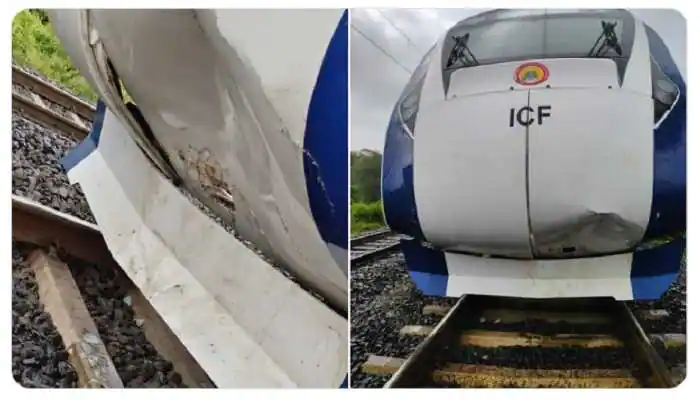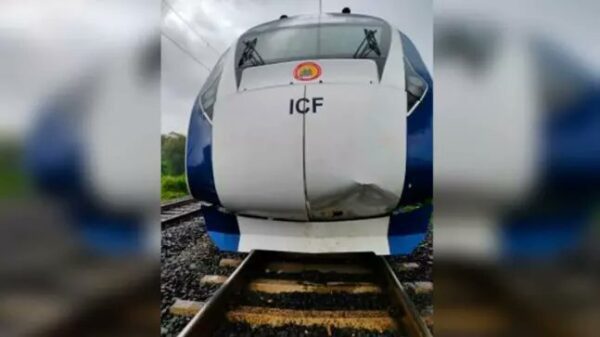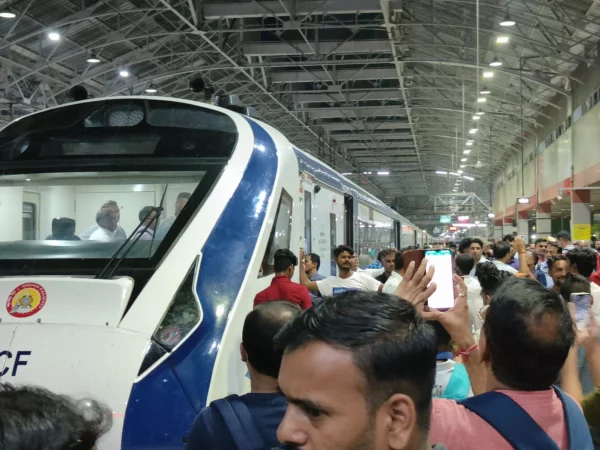Mumbai-Gandhinagar Vande Bharat Express Runs into Cattle for the 2nd Consecutive Day

The Gandhinagar-Mumbai Vande Bharat Express ran into cattle for the second consecutive day en route to Mumbai. The incident happened in Gujarat’s Kheda district at about 4 p.m on Friday when the Vande Bharat Express struck a cow at the Kanjari Boriyavi station.
The Gandhinagar-Mumbai Vande Bharat Express ran into cattle for the second consecutive day en route to Mumbai.
The collision took place on the same day that Railway Minister Ashwini Vaishnaw said that collisions on tracks with cattle are unavoidable.
The incident happened in Gujarat’s Kheda district at about 4 p.m. on Friday when the Vande Bharat Express struck a cow at the Kanjari Boriyavi station.
Meanwhile, on Thursday, the Vande Bharat express on its journey to Gandhinagar also struck four buffaloes at Vatva, close to Ahmedabad.
On Friday evening, railway officials announced that the train, which had been left with a damaged front for the second day in a row, would undergo repair after 8 pm that evening upon its arrival in Mumbai.
It may be mentioned here that barely a week after Prime Minister Narendra Modi’s inauguration, the Gandhinagar-Mumbai Vande Bharat (VB) Express required two facelifts.
The Vande Bharat trains have been lauded by the Center as the future of rail mobility, but repeated cattle hits and mechanical difficulties are starting to call into question that assertion.
Despite the broken nose, which had only been fixed Thursday evening after the train reached Mumbai following a collision with buffaloes that same day, the train was on schedule, according to railroad officials. The cow that collided with the train on Friday died, according to railway officials, but there were no injuries to people.

Officials from the railway claim that the impact on the nose cones was caused by the design of the most recent VB trains. The current VB-2 is a more advanced “lightweight” version of the VB-1 that is also a lot quicker. The nose of the train is built of fibre-reinforced plastic, making it 38 tonnes lighter than the VB-1.
Officials from the railway claim that the impact on the nose cones was caused by the design of the most recent VB trains. The current VB-2 is a more advanced “lightweight” version of the VB-1 that is also a lot quicker. The nose of the train is built of fibre-reinforced plastic, making it 38 tonnes lighter than the VB-1.
A senior railway officer stated that using stronger materials to construct the front would have resulted in greater train damage since the impact would have been transmitted rather than reduced with the nose. VB’s trains don’t have separate locomotives and coaches, as some others do. Therefore, the nose cone acts as a reusable bumper to protect operational components from collision.
The Indian Railways is also apparently preparing to install fences around the railroad lines on VB routes, in addition to the temporary fix of spare cones to prevent accidents.
Notably, Railway Minister Vaishnaw was just a few kilometres from the scene of Friday’s accident in the Anand area on the day of the disaster. Vaishnaw responded that the train had been built to withstand “unavoidable” collisions with cattle when questioned about the tragedy on Thursday.
The Minister added that the train is sturdy and designed to withstand accidents and said that railway tracks are on accessible grounds in India and so cattle cross railway tracks everywhere. It is impossible to stop them. Only by raising tracks in the coming years can such collisions with cattle be avoided. Until then, it is unavoidable when trains are travelling at high speeds of 120, 130, or 160 kph, he said.
Vaishnaw also stated that the collisions with the Vande Bharat train will not result in any casualties and mentioned that the train has been thoughtfully designed to be strong, with the goal of being able to be repaired immediately in the event of an accident.
The train was cleaned and its nose was repaired as soon as it arrived in Mumbai on Thursday following Vatva-Gandhinagar. One cannot hear any noise inside the air spring of the train, which serves as a shock absorber. The minister stated that 200kmph will be the top speed of the upcoming Vande Bharat.

After officially inaugurating the newly renovated Anand railway station, Vaishnaw spoke with students at the engineering college in Vallabh Vidyanagar and said that it was Prime Minister Narendra Modi’s vision that 199 railway stations across India were to undergo redevelopment in the coming years.
After officially inaugurating the newly renovated Anand railway station, Vaishnaw spoke with students at the engineering college in Vallabh Vidyanagar and said that it was Prime Minister Narendra Modi’s vision that 199 railway stations across India were to undergo redevelopment in the coming years.
The minister also told the students about how the Prime Minister took the Vande Bharat train’s first run. He said that Modiji spoke to the technicians and welders while travelling 40 kilometres on the train and took pictures eight or nine times, standing unaided on the train even as it was moving at such a high speed. That was because vibrations within the train cannot be felt and the decibel levels of noise are low, making this a world-class train.

Besides, the railways have so far removed 213 manned level crossings in 2022–2023 and constructed 250 ROBs/RUBs. It has declared that its broad-gauge network is free of unmanned crossings. It intends to remove 1,000 level crossings throughout this financial year.
The VB-2’s problems, according to experts, might be solved by upgrading the local infrastructure. They emphasize that the trains’ lightweight construction is what allows for higher speeds, and that needless design modifications could reduce the VB-2’s effectiveness.
edited and proofread by nikita sharma




